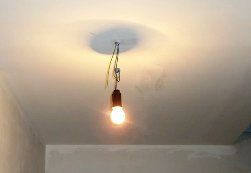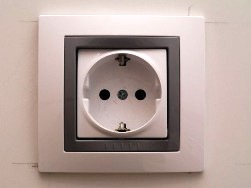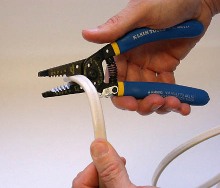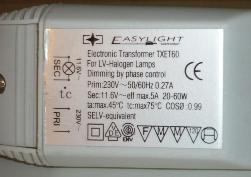How is the supply of electricity to our homes
Electricity supply to apartment buildings and private houses.
 How many of us think about how electricity gets into our home. Remembering school physics lessons, you can draw about the following diagram:
How many of us think about how electricity gets into our home. Remembering school physics lessons, you can draw about the following diagram:
Electricity is generated at power plants, then transmitted via VLEP (high-voltage power lines), then it gets to city and regional distribution zones.
After the RES, electricity goes to the transformer substations, where it drops to the required 380/220 Volts. And these same 380/220 volts we get in the end at home. Here we will consider the last step in more detail ...
How to connect wires correctly
 An electrician is the science of contacts ... Almost every electrician knows, or at least heard this phrase. And the fact that this phrase is not taken from the ceiling, many learn in practice.
An electrician is the science of contacts ... Almost every electrician knows, or at least heard this phrase. And the fact that this phrase is not taken from the ceiling, many learn in practice.
Almost all the problems associated with electricity arise due to congestion in the wiring, which is quite relevant today, or because of poor contact in the soldering (dose) boxes or in the end devices (sockets, switches, lamps) themselves.
How is it better to connect the wires so that there is a reliable contact and so as not to have problems in the future? To begin, let's look at which compounds are most often found ...
Technical tricks of household outlets
 Most manufacturers of sockets, switches spend considerable money on ensuring maximum security for ordinary consumers and raising the level of comfort during the operation of electrical appliances.
Most manufacturers of sockets, switches spend considerable money on ensuring maximum security for ordinary consumers and raising the level of comfort during the operation of electrical appliances.
For example, many manufacturers equip their sockets with protective curtains. It will not work to insert any foreign object other than the plug from electrical appliances into the outlet of the outlet.
These sockets are ideal for installation in apartments where young children grow. Because the curiosity of the kids is no secret, many of the kids constantly strive to stick something into the socket outlet. In addition, recently, almost everyone who makes repairs install sockets at a level of 35-40 cm from the floor. The presence of curtains also serves as additional protection against ingress of foreign objects, dust, moisture into the outlet mechanism ...
Replacing wiring. Little tricks
 The article will be interesting to people who decided to independently change the wiring in the apartment, house.
The article will be interesting to people who decided to independently change the wiring in the apartment, house.
If you believe the statistics, the average homeowner (sorry for the officialdom) makes cosmetic repairs every 3-5 years, major repairs - once every 8-12 years. What is a facelift? This is a replacement for wallpaper, painting the ceiling, walls, windows, batteries ... That is, repair without significant investments.
Overhaul implies something more that requires significant financial costs. With major repairs, many change plumbing, heating appliances, tiles in bathrooms and in the kitchen. Someone is changing the flooring. Instead of old linoleum, they lay a laminate. There are many options. Everyone makes repairs based on their financial capabilities.
During the repair process, do not forget about the wiring ...
How to choose a circuit breaker for home, apartment
 Before choosing a circuit breaker, let's try to figure out what it is and what it is for. So, the circuit breaker is designed primarily to protect the supply lines, that is, the wires, from overload, short circuit.
Before choosing a circuit breaker, let's try to figure out what it is and what it is for. So, the circuit breaker is designed primarily to protect the supply lines, that is, the wires, from overload, short circuit.
Most often, to protect the home electrical network, we use machines of the VA series. VA series machines have two types of protection: thermal and electromagnetic. Almost all modern automatic devices are arranged almost the same way: an arcing chamber, a magnetic release and a bimetallic plate, a contact group, a linkage ...
RCD - causes of operation and how to deal with it
 RCD - residual current device. Many probably heard, but someone probably knows what this device is, what it is for and how it works. Without really going into the jungle of physics, we will briefly try to understand the device, the principles of operation of this RCD itself in a simple human language.
RCD - residual current device. Many probably heard, but someone probably knows what this device is, what it is for and how it works. Without really going into the jungle of physics, we will briefly try to understand the device, the principles of operation of this RCD itself in a simple human language.
So, as the name implies, this device is designed to protect against electric shock. The principle of operation of the device is based on a comparison of currents along the conductors at the input and output of the device. The currents must be equal. If there is a slight difference, the device “sees” it and immediately disconnects the load from the network. The response time, by standards, should be no more than 15-25 ms.
Now, in fact, we begin to review the reasons due to which, in practice, the operation of RCDs takes place ...
How to lay the cable and connect the fixtures in the garden
 To power the luminaires, it is best to use a cable specially designed for this. An ideal option would be to use an armored cable, such as a VBBSHV or AVBBSHV cable (aluminum conductors).
To power the luminaires, it is best to use a cable specially designed for this. An ideal option would be to use an armored cable, such as a VBBSHV or AVBBSHV cable (aluminum conductors).
Such a cable, thanks to protective armor, is protected from accidental mechanical damage. The insulation of the cable from polyvinyl chloride plastic compound (PVC) will protect the cable from the aggressive effects of soil.
In addition to the armored cable, cable laying without armor is possible. But in this case, it is recommended to lay the cable in asbestos-cement or polyethylene pipes.
Many electricians use an ordinary corrugated pipe or metal hose to protect against mechanical damage. This, let's say, is not entirely correct ...
 Recessed spotlights today have become the same mundane normal thing in the interior of a house, apartment, office as an ordinary chandelier or fluorescent lamp.
Recessed spotlights today have become the same mundane normal thing in the interior of a house, apartment, office as an ordinary chandelier or fluorescent lamp.
Many probably paid attention to the fact that sometimes light bulbs, if there are several, in these same spotlights shine differently. Some lamps shine quite brightly, while others burn, at best, at half light. In this article we will try to deal with the essence of the problem.
So, for starters, a little theory. Halogen bulbs installed in recessed downlights are designed for operating voltage of 220 V and 12 V. In order to connect bulbs designed for voltage of 12 V, a special transformer device is required ...
